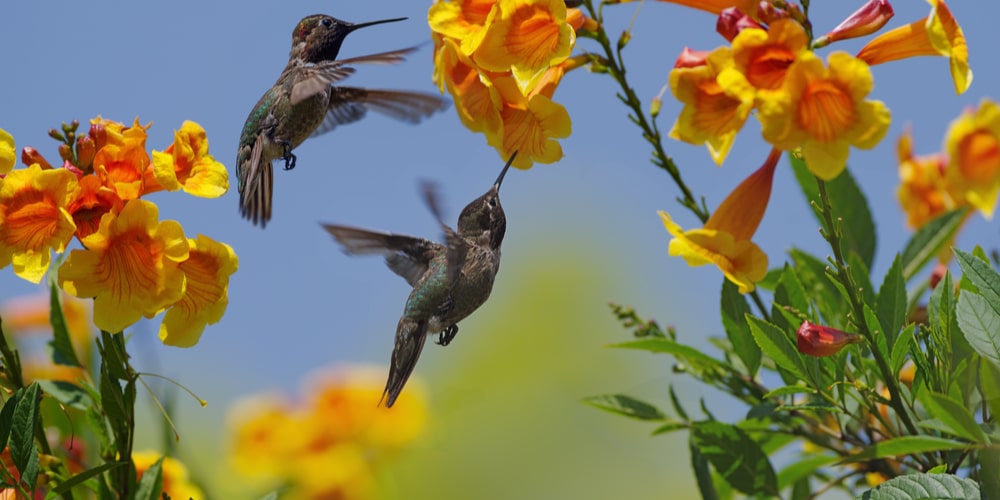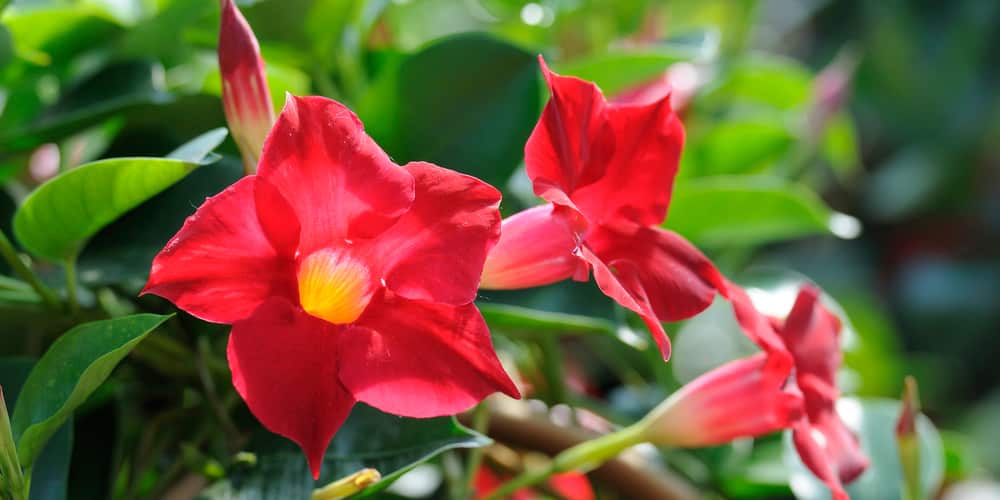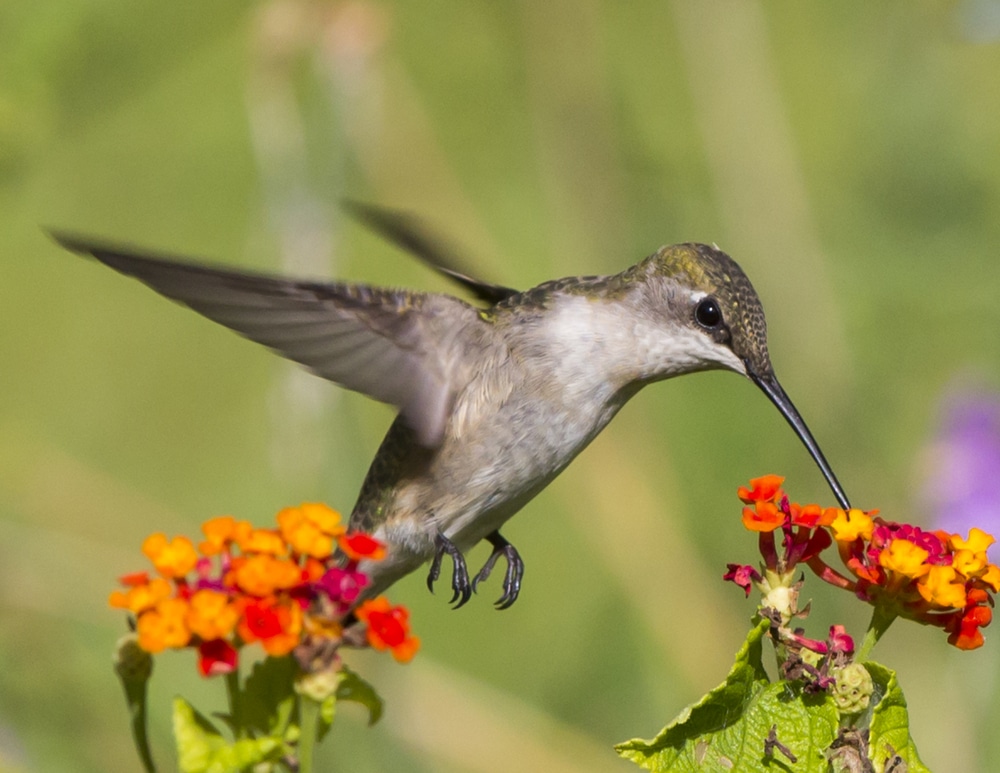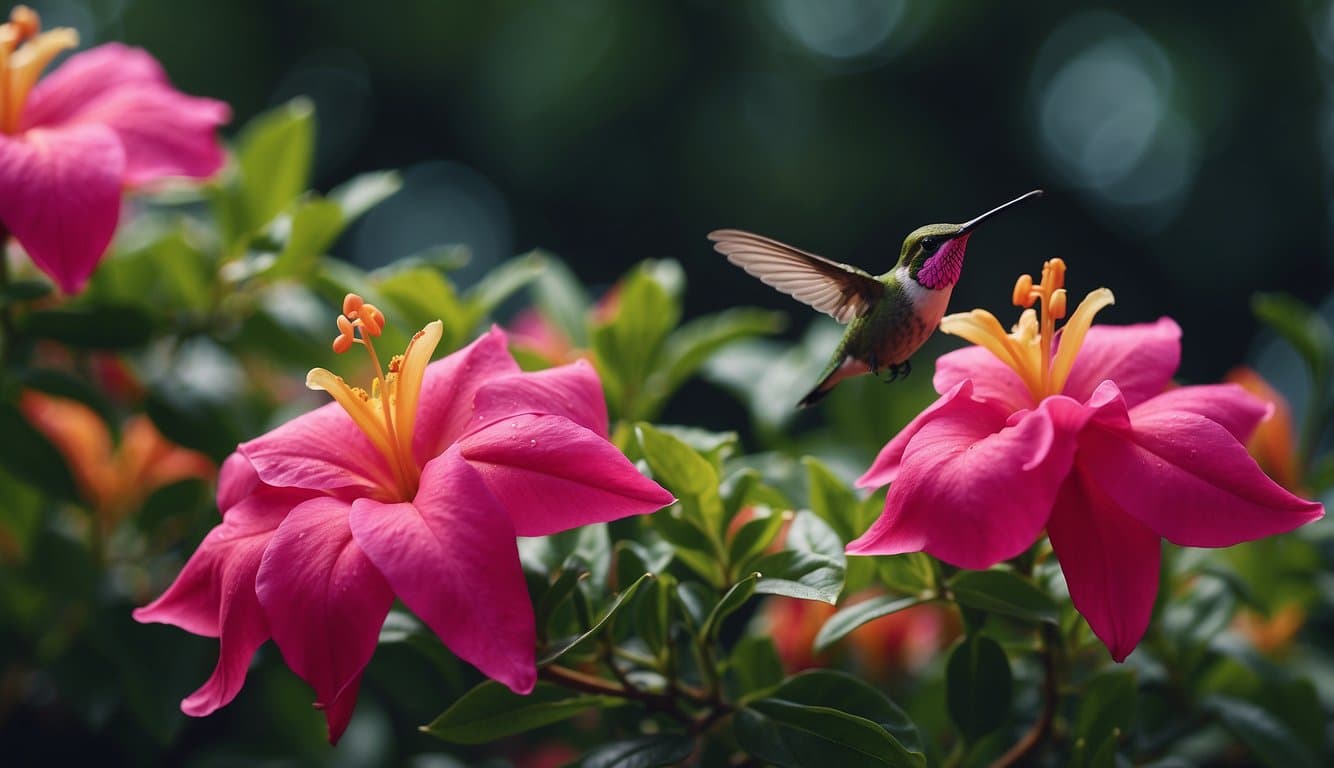Quick Attraction Guide

Here’s the gist of this article; if you want to learn more, please read it. But you’ll go far with this list:
- Dipladenia’s bright, tubular flowers are highly attractive to hummingbirds.
- Plant in sunny areas to promote flowering.
- Use well-draining soil and ensure regular watering.
- Fertilize properly to encourage blooms.
- Position plants in your garden where you can easily observe the visiting hummingbirds.
Easy, right?
Intro
Gardeners and bird enthusiasts often aim to create spaces that are not only beautiful but also serve as havens for wildlife, such as hummingbirds.
These tiny, energetic birds are always searching for nectar-rich flowers, and certain plants have the power to draw them into a garden.
Dipladenia, with its trumpet-shaped flowers, is such a plant that stands out for its visual appeal and potential to attract these flying jewels.
The vivid colors and tubular shape of Dipladenia flowers are particularly enticing for hummingbirds.
These characteristics, combined with the ease of access to nectar, make Dipladenia an excellent choice for anyone looking to invite more hummingbird activity into their garden.
Additionally, the plant’s growth habits and care requirements align well with the preferences of these birds, guaranteeing a regular visit from them throughout the blooming season.
Key Takeaways
- Dipladenia offers nectar-rich flowers that are attractive to hummingbirds.
- The plant’s bright, tubular flowers facilitate easy nectar access for the birds.
- Dipladenia’s growth habits are well-suited for gardens aiming to attract hummingbirds.
Store Bought Nectar Goodness:
Hummingbird Nectar Preferences
In the intricate dance of nature, hummingbirds show particular affinities for certain plants, key among them, Dipladenia.
Their behavior reflects evolved preferences, notably for specific flower traits and nectar characteristics.
Attraction to Dipladenia
Dipladenia, also known as Mandevilla, sports trumpet-shaped flowers that serve as hummingbird magnets.
These blooms are not just visually appealing with their vibrant reds and pinks, but they are structured in a way that caters to the feeding habits of hummingbirds.
- Bright colors: particularly reds and pinks
- Flower shape: trumpet-like blossoms facilitate nectar feeding
Nectar Preferences
When sourcing food, hummingbirds prefer flowers with abundant and sweet nectar.
Dipladenia flowers are rich in nectar, which provides
- High energy: essential for hummingbirds’ high metabolism
- Easy access: long petals of Dipladenia make nectar accessible
The nectar’s sugar concentration and the consistency of its production throughout the day are crucial factors that sway a hummingbird’s preference.
Dipladenia Overview
Dipladenia, also known by its botanical genus Mandevilla, draws attention with its vivacious blooms and glossy foliage. It enchants gardeners and hummingbirds alike, promising vibrant aesthetics and a nectar-rich haven.
Plant Characteristics
Dipladenia (Mandevilla spp.) exhibits a growth pattern characteristic of a tropical vine.
It showcases fine pointed leaves and bears trumpet-shaped flowers that come in an array of colors including pink, white, red, and yellow.
The leaves imbue a dark green color, sometimes variegated, adding to the visual interest of the plant.
- Leaves: Glossy, variegated or solid dark green.
- Flowers: Trumpet-shaped, available in pink, white, red, yellow.
- Growth: Can extend up to 20 feet in length.
Cultivation and Care
Dipladenia flourishes in warm climates due to its tropical origins.
Gardeners aiming to cultivate Dipladenia should be aware that it may struggle in colder climates.
In regions prone to colder temperatures, they might need to bring the plant indoors or provide protection during the freezing months.
- Climate: Prefers warm, tropical climates.
- During cold months: Lift plants, transfer indoors or to a greenhouse.
- Soil requirements: Well-draining soil enriched with organic matter.
- Water: Evenly moist, but avoid waterlogging.
- Lighting: Thrives in full sun to partial shade.
Gardening Tips for Attracting Hummingbirds
Creating a hummingbird-friendly garden involves careful selection of plants and strategic feeder placement.
These birds are attracted to areas that cater to their feeding habits and provide a safe environment.
Flower Selection
Plants That Attract Hummingbirds:
- Annuals: Impatiens and petunias offer bright blossoms.
- Perennials: Bee balms and columbines are long-lasting favorites.
- Shade Tolerance: Opt for plants like daylilies for partial shade areas.
Plants with tubular flowers in shades of red and orange are particularly appealing to hummingbirds as they are rich in nectar.
However, hummingbirds do not show a particular preference for dipladenia (Mandevilla spp.), as it’s not recognized as a traditional hummingbird attractor due to its flower shape and nectar production.
Feeder Placement and Maintenance
Feeder Location:
- Place feeders in quiet, sheltered locations.
- Position near natural shelter but in a visible spot.
Feeder Care:
- Clean feeders regularly to prevent mold and bacteria.
- Change nectar every 2-3 days, more often in hot weather.
Nectar Recipe: A simple mixture of one part sugar to four parts water mimics natural nectar without any harmful dyes. Feeders with red parts help attract hummingbirds without the need for colored solutions.
Frequently Asked Questions
When considering the cultivation of flowers that attract hummingbirds, enthusiasts often have queries about the types of flowers to select, care routines, and regional considerations to keep these vibrant birds frequenting their gardens.
What kind of flowers are attractive to hummingbirds in various regions?
In various regions, hummingbirds are drawn to a diverse array of flowers, typically those that are brightly colored and rich in nectar. Red and pink trumpet-shaped flowers, such as Dipladenia, are particularly favored in many areas due to their color and shape which facilitate nectar feeding.
What are the blooming periods for popular hummingbird-attracting plants?
The blooming period for plants that attract hummingbirds, like Dipladenia, can vary depending on the species and climate. For instance, Dipladenia flowers may bloom throughout the warm season in warmer climates, providing a continuous nectar source for hummingbirds.
What is the growth rate and care involved for flowers that attract hummingbirds?
Flowers that appeal to hummingbirds, including Dipladenia, often exhibit fast growth under optimal conditions. These plants typically require ample sunlight, well-draining soil, and regular watering to thrive and continuously attract hummingbirds with their blooms.
How should one maintain plants to keep them attractive to hummingbirds?
To maintain plants in a way that keeps them alluring to hummingbirds, one must ensure that the plants are healthy and the flowers are abundant. Regular pruning, fertilizing, and maintenance of soil moisture levels are critical practices for sustaining flower production that draws in hummingbirds.
Do certain flowers emit scents that are particularly attractive to hummingbirds?
While hummingbirds do not heavily rely on scented flowers, as their primary attraction to flowers is visual and related to nectar accessibility, some plants that attract hummingbirds may have a subtle fragrance. Dipladenia, however, is primarily attractive due to its vibrant, nectar-rich blossoms.
What are the survival traits of hummingbird-friendly flowers in different climates?
Hummingbird-friendly flowers like Dipladenia have various survival traits that enable them to adapt to different climates.
Tropical plants like Dipladenia may struggle in colder climates and require protection. This includes being brought indoors or sheltered in greenhouses during cold spells to survive and continue to attract hummingbirds.
Last update on 2025-06-06 / Affiliate links / Images from Amazon Product Advertising API





